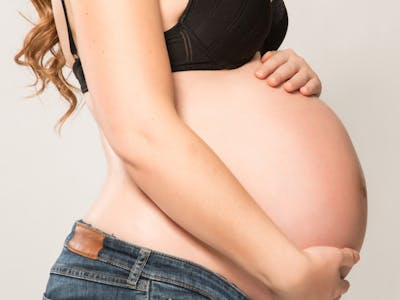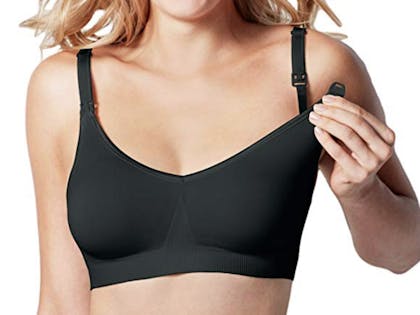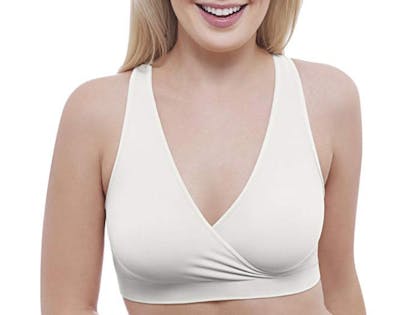buying guides
The best (and most comfortable) nursing and maternity bras

This page contains affiliate links, which means we may earn a small amount of money if a reader clicks through and makes a purchase. All our articles and reviews are written independently by the Netmums editorial team.
A decent bra is one of the most important maternity products you’ll buy.
Tender and expanding boobs are often one of the first signs of pregnancy and good support right from the early stages will help to ease any discomfort.
As your pregnancy progresses, your breasts will continue to change shape and size, and may also begin to leak a little.
Making sure you’re wearing a well-fitted bra throughout will keep you comfortable and can also help to prevent post-pregnancy droop.
Many maternity bras can also be used after your baby is born for nursing.
A nursing bra is one of the most important piece of breastfeeding kit you'll need.
It has two main purposes: to give your bust the support it needs for breastfeeding, and to make it physically easier and more discreet to feed your baby.

1. Bravado Nursing Bra
*Available in several colours and sizes
*91% nylon, 9% spandex/elastane
*Seamless design in silky fabric for all-day comfort
We like this seam-free bra by Bravado, it's available in a wide range of sizes and colours and offers comfort and support throughout pregnancy. It also has drop down cups, so it can be used for nursing once your baby is born.

2. Naturana Women's Nursing Bra
* Moulded cups can be opened with one hand
*Made from 83% nylon, 17% elastane
*Machine-wash warm at 30°
If you thought that all maternity bras are frumpy, think again! This chic pinstripe number by Naturana has all the comfortable styling and practical features you need, but looks like an everyday bra.

3. Medela Sleep Bra
*Made from stretch fabric and criss cross back
*Easy access for night time feeding
*Material 92% nylon, 8% elastane
Medela are feeding specialists, but their sleep bra can be worn during pregnancy as well as night feeds. It offers gentle support, adapts to your body as your shape changes, and is made from stretch fabric with a criss cross design.
How much does a maternity or nursing bra cost?
Just as ordinary lingerie spans a huge range of prices from dirt-cheap to designer, so do maternity bras.
If you’re on a tight budget, you can pick up a basic bra from your local supermarket for under £10 – don’t expect many frills or features for that price, though.
Most maternity bras ring in somewhere around the £20-£30 mark. This will buy you a good, supportive bra with some concession to style.
If you’re into your luxury lingerie, there are a number of high-end maternity bras that boast designer looks and sensual fabrics, often with matching underwear available too.
These could set you back anywhere from £60 to £90, but are worth it if you’re aiming for ‘pregnant and sexy’.
Key features
There's a number of details to look out for when you’re choosing maternity bras, but the most important is good support.
A decent maternity bra needs wide shoulder straps and a deep under-bust band to help support the weight of your growing boobs.
There should also be scope to adjust the bra, as your size is likely to change throughout pregnancy.
Look out for plenty of strap length, and at least four rows of hooks on the back so you can let it out as you grow.
While you may be used to wearing underwired bras, it’s best to avoid these during pregnancy, as the wiring could damage your delicate breast tissue.
It’s also a good idea to look for a bra that has good coverage, rather than balcony or plunge styles.
This will keep you comfy as your boobs grow.
As far as fabric is concerned, cotton tends to be a good bet as it’s breathable and will stop you getting too hot and sweaty – a perennial pregnancy problem.
There’s no need to rule out luxury fabrics, though, but it’s worth making sure that your chosen style is machine-washable, especially once you enter the leaky boobs stage.
As your breasts get bigger and start producing milk, you might find you need a bit of support overnight.
You can wear a regular maternity bra in bed, but a special sleep bra might prove more comfortable.
These are usually crop-top style and fairly inexpensive.
When you’re choosing a nursing bra, it’s important to make sure it offers good support, as your breasts are likely to fluctuate in size and tenderness until breastfeeding is established.
Because your chest size will change as your ribs settle back into their normal position post-pregnancy, you’ll need at least four rows of hook and eye fastenings at the back so you can tighten the bra as your figure returns to normal.
The milk-producing tissue in your breasts is very sensitive, and if it’s too restricted, you can develop blocked milk ducts, which may then turn into mastitis – a painful infection of the ducts.
For that reason, you should avoid wearing underwired bras when you’re pregnant or breastfeeding.
To make breastfeeding easier and more discreet, your baby needs easy access to your boobs, so nursing bras have drop cups: that is, the front of the cups is made of a separate piece of fabric, which you unclip and pull down to let your baby get to your breast.
Check that the cups are easy to unclip and clip back up – ideally one-handed, as you’ll probably be holding your baby in the other arm.
Padded cups may give you a nicer silhouette, but the extra fabric can get in your baby’s way when feeding.
In the early stages of breastfeeding at least, you’ll need to wear breast pads to absorb leaking milk until your supply settles down.
For this reason, look for a bra that has generous cups that cover most of your breast to hold your breast pads securely in place.
In early pregnancy, choose a bra that fastens on its tightest setting at the back.
One more thing to note is that many maternity bras do double duty as nursing bras.
The key feature to look for here is drop cups: that is, where the front unclips and drops down to allow your baby easy access.
If you’re bra shopping in the late stages of pregnancy, this is a useful feature as you’ll be able to carry on wearing the same bras after the birth.
Need to know
Because your bra size tends to change so often in pregnancy – and because maternity bras fit rather differently from what you’re used to – it’s a good idea to get professionally measured.
You can get this done in department stores, baby shops and lingerie stores, or by an NCT bra fitter.
Ideally, you should be re-measured every couple of months throughout pregnancy, but at the very least in the first trimester and then again a few weeks before your due date.
In early pregnancy, choose a bra that fastens on its tightest setting at the back.
This will give you growing room.
In the later stages, pick one that you can do up on one of the last rows of hooks: although your breasts will initially get bigger when your milk comes in, your ribcage will shrink post-pregnancy, so you’ll need to be able to do your bra up tighter.
You may also need to get re-measured once breastfeeding is well established – usually between six and 12 weeks after the birth – to check that your bras are still a good fit.
 '
'
Checklist
- Maternity bras should be non-wired with wide shoulder straps and a deep band under your breasts for good support.
- Aim to get professionally measured in the first trimester, and again a few weeks before the birth.
- A drop-cup bra will see you through from pregnancy to breastfeeding, so your money stretches further
Read on:
- The best changing bags for fashionistas
- The best maternity jeans for every budget
- Maternity clothes: what you need and what you don't
